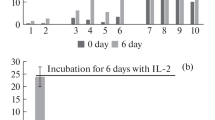Summary
The kinetics of interleukin-2 receptor (IL-2R) expression and the [3H]dT incorporation of blood lymphocytes after the first and the second stimulation with allogeneic leukocytes (primary and secondary MLC) or with the autologous tumor cells (primary and secondary MLTC) were compared. The expression of IL-2R paralleled the induction of DNA synthesis. The proportion of IL-2R+ cells of the unprimed donors peaked earlier in the secondary MLC as compared to the primary MLC (on days 3 and 5 respectively). In MLC of alloimmunized healthy individuals and in the MLTC of cancer patients the highest proportions of IL-2R+ cells were detected between days 2 and 3 after both the first and second stimulations. Thus the first in vitro stimulation in the MLTC showed similar kinetics to those of the secondary MLC of unprimed individuals and to the primary MLC response of the allo-immunized individuals. The findings in the MLTC substantiate the hypothesis that cancer patients can be sensitized to their own tumors. The kinetics of the appearance of the IL-2R together with the characteristics of the IL-2-propagated cultures provide useful information for the strategy of expansion of auto-tumor reactive lymphocyte populations.
Similar content being viewed by others
References
Ashwell JD, Robb RJ, Malek TR (1986) Proliferation of T lymphocytes in response to interleukin 2 varies with their state of activation. J Immunol 137: 2572
Curtis JE, Hersh EM, Harris JE, McBride C, Freireich EJ (1970) The human primary immune response to a keyhole limpet haemocyanin: inter-relationships of delayed hypersensitivity, antibody response and in vitro blast transformation. Clin Exp Immunol 6: 743
Hemler ME, Brenner MB, McLean JM, Strominger JL (1984) Antigen stimulation regulates the level of expression of interleukin 2 receptor on human T cells. Proc Natl Acad Sci USA 81: 2172
Leonard WJ, Depper JM, Uchiyama T, Smith KA, Waldmann TA, Greene WC (1982) A monoclonal antibody that appears to recognize the receptor for human T-cell growth factor; partial characterization of the receptor Nature 300: 267
Lipkowitz S, Greene WC, Rubin AL, Novogrodsky A, Stenzel KH (1984) Expression of receptors for interleukin 2: role in the commitment of T lymphocytes to proliferate. J Immunol 132: 31
Maryanski JL, Pala P, Cerottini J-Ch, MacDonald HR (1988) Antigen recognition by H-2-restricted cytolytic T lymphocytes: inhibition of cytolysis by anti-CD8 monoclonal antibodies depends upon both concentration and primary sequence of peptide antigen. Eur J Immunol 18: 1863
Meltzer MS, Oppenheim JJ, Littman BH, Leonard JE, Rapp HJ (1972) Cell-mediated tumor immunity measured in vitro and in vivo with soluble tumor specific antigens. J Natl Cancer Inst 49: 427
Mills JA (1966) The immunologic significance of antigen induced lymphocyte transformation in vitro. J Immunol 97: 239
Robb RJ, Greene WC, Rusk CM (1984) Low and high affinity cellular receptors for interleukin 2. Implications for the level of Tac antigen. J Exp Med 160: 1126
Rosenberg SA (1988) Immunotherapy of cancer using interleukin 2: current status and future prospects. Immunology Today 9: 58
Siegel JP, Sharon M, Smith PL, Leonard WJ (1987) The IL-2-R β chain (p 70): role in mediating signals for LAK, NK, and proliferative activities. Science 238: 75
Vánky F (1986) Membrane structures involved in auto-tumor recognition. Biochim Biophys Acta 865: 253
Vánky F, Klein E, Stjernswärd J, Nilsonne U (1974) Cellular immunity against tumor-associated antigens in human: lymphocyte stimulation and skin reaction. Int J Cancer 14: 277
Vánky F, Klein, Willems J, Böök K, Ivert T, Péterffy A, Nilsonne U, Kreicbergs A, Aparisi T (1986) Lysis of autologous tumor cells by blood lymphocytes tested at the time of surgery. Correlation with the postsurgical clinical course. Cancer Immunol Immunother 21: 69
Vánky F, Stuber G, Willems K, Sjöwall K, Larsson B, Böök K, Ivert T, Péterffy A, Klein E (1988) Importance of MHC antigen expression on solid tumors in the in vitro interaction with autologous blood lymphocytes. Cancer Immunol Immunother 27: 213
Vánky F, Wang P, Patarrayo M, Klein E (1989) Expression of the adhesion molecule ICAM-1 and major histocompatibility complex class I antigens on human tumor cells is required for in vitro interaction with autologous lymphocytes. Cancer Immunol Immunother (in press).
Vose BM, Vánky F, Klein E (1977) Lymphocyte cytotoxicity against autologous tumor biopsy cells in humans. Int J Cancer 20: 512
Author information
Authors and Affiliations
Rights and permissions
About this article
Cite this article
Stuber, G., Vánky, F., Pócsik, E. et al. Expression of interleukin-2 receptor on blood lymphocytes stimulated with allogeneic lymphocytes or autologous tumor cells. Cancer Immunol Immunother 31, 76–80 (1990). https://doi.org/10.1007/BF01742369
Received:
Accepted:
Issue Date:
DOI: https://doi.org/10.1007/BF01742369




